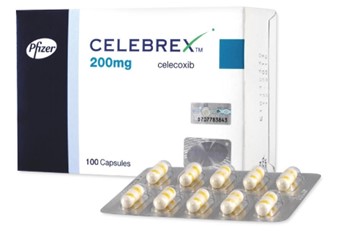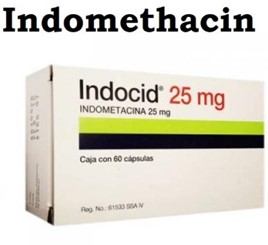Anti-inflammatory and Immunosuppressive Drugs > Pharmacology
Exam Review
Contraindications of NSAIDs
Total Questions : 5
Showing 5 questions, Sign in for moreA nurse is teaching a client who has osteoarthritis and is prescribed celecoxib (Celebrex), a selective COX-2 inhibitor. What should the nurse include in the teaching?
Explanation
A. The drug has less gastrointestinal toxicity than nonselective COX inhibitors because it does not interfere with gastric mucosal protection by prostaglandins.
This is because celecoxib (Celebrex), a selective COX-2 inhibitor, selectively inhibits the cyclooxygenase-2 (COX-2) enzyme, which is responsible for prostaglandin synthesis in inflammation, pain, and fever¹. Prostaglandins produced by the cyclooxygenase-1 (COX-1) enzyme, which is not affected by celecoxib, have protective effects on the gastrointestinal mucosa and platelet function¹. Therefore, celecoxib has less risk of causing gastrointestinal ulceration and bleeding than nonselective COX inhibitors, which block both COX-1 and COX-2 enzymes²³.
The other options are wrong because they are either false or contradictory to the facts about celecoxib (Celebrex), a selective COX-2 inhibitor.
- Option B is wrong because celecoxib does not block both COX-1 and COX-2 enzymes, but only COX-2 enzyme. Therefore, it does not have more anti-inflammatory and analgesic effects than nonselective COX inhibitors, but similar effects .
- Option C is wrong because celecoxib does not inhibit vasodilatory and antiplatelet prostaglandins produced by COX-2 in the endothelium, but rather it inhibits the production of these prostaglandins by COX-2 in the inflammatory sites. Therefore, it does not have less cardiovascular risk than nonselective COX inhibitors, but more risk .
- Option D is wrong because celecoxib does not block the production of prostaglandins involved in fever and platelet aggregation, but rather it spares the production of these prostaglandins by COX-1. Therefore, it does not have more antipyretic and antiplatelet effects than nonselective COX inhibitors, but none or minimal effects .

A nurse is administering aspirin (ASA), a nonselective COX inhibitor, to a client who has rheumatoid arthritis. What are some of the specific indications of aspirin in this condition?
Explanation
A. It reduces inflammation, pain, fever, and platelet aggregation by blocking the production of prostaglandins.
This is because aspirin (ASA), a nonselective COX inhibitor, inhibits both cyclooxygenase-1 (COX-1) and cyclooxygenase-2 (COX-2) enzymes, which are responsible for prostaglandin synthesis in various tissues¹. Prostaglandins are involved in inflammation, pain, fever, and platelet aggregation. Therefore, aspirin has anti-inflammatory, analgesic, antipyretic, and antiplatelet effects¹².
- Aspirin is used to relieve the symptoms of rheumatoid arthritis (arthritis caused by swelling of the lining of the joints), osteoarthritis (arthritis caused by breakdown of the lining of the joints), systemic lupus erythematosus (condition in which the immune system attacks the joints and organs and causes pain and swelling) and certain other rheumatologic conditions (conditions in which the immune system attacks parts of the body)¹.
- Aspirin is also used to prevent cardiovascular events such as myocardial infarction and stroke by inhibiting platelet aggregation and thromboxane synthesis¹². However, this effect requires low doses of aspirin (typically 75 to 81 mg/day) that are insufficient to inhibit COX-2 and have anti-inflammatory effects².
- Aspirin does not treat gouty arthritis by inhibiting the enzyme xanthine oxidase and reducing the production of uric acid. This is the mechanism of action of allopurinol, a drug used for gout³. In fact, aspirin can worsen gout by increasing uric acid levels in the blood and decreasing its excretion in the urine⁴.
- Aspirin does not induce labor by stimulating uterine contractions and cervical ripening by blocking the production of prostaglandins. This is the mechanism of action of misoprostol, a synthetic prostaglandin E1 analog used for labor induction. In fact, aspirin is contraindicated in pregnancy because it can cause bleeding complications, premature closure of the ductus arteriosus, and delayed onset of labor¹ .
The other options are wrong because they are either false or irrelevant to the specific indications of aspirin (ASA), a nonselective COX inhibitor, in rheumatoid arthritis.
- Option B is wrong because it is not a specific indication of aspirin in rheumatoid arthritis, but a general indication of aspirin in cardiovascular prevention. Aspirin can prevent cardiovascular events such as myocardial infarction and stroke by inhibiting platelet aggregation and thromboxane synthesis, but this effect requires low doses of aspirin that are not effective for rheumatoid arthritis .
- Option C is wrong because it is not the mechanism of action of aspirin, but of allopurinol, a drug used for gout. Aspirin does not inhibit the enzyme xanthine oxidase and reduce the production of uric acid, but rather it inhibits both COX-1 and COX-2 enzymes and blocks the production of prostaglandins. Aspirin is not used to treat gouty arthritis, but rather it can worsen it by increasing uric acid levels in the blood and decreasing its excretion in the urine.
- Option D is wrong because it is not the mechanism of action of aspirin, but of misoprostol, a drug used for labor induction. Aspirin does not stimulate uterine contractions and cervical ripening by blocking the production of prostaglandins, but rather it inhibits both COX-1 and COX-2 enzymes and blocks the production of prostaglandins. Aspirin is not used to induce labor, but rather it is contraindicated in pregnancy because it can cause bleeding complications, premature closure of the ductus arteriosus, and delayed onset of labor.
A nurse is monitoring a client who has gout and is receiving indomethacin (Indocin), a nonselective COX inhibitor. What are some of the adverse effects that the nurse should watch for?
Explanation
This is because indomethacin can cause gastrointestinal, renal, and cardiovascular effects as a result of its nonselective inhibition of cyclooxygenase (COX) enzymes. COX enzymes are responsible for producing prostaglandins that have different functions in different tissues. By blocking both COX-1 and COX-2 enzymes, indomethacin can interfere with the protective, regulatory, and homeostatic roles of prostaglandins in various organs. Therefore, the nurse should monitor the client for the following adverse effects:
A. Gastrointestinal effects such as nausea, vomiting, ulceration, bleeding, and perforation:
These are the most common and serious side effects of indomethacin and other NSAIDs . They occur because indomethacin blocks the production of prostaglandins that protect the gastric mucosa from acid and pepsin, maintain the mucosal blood flow, and promote healing of ulcers. The risk of these effects is higher in older adults, those with a history of peptic ulcer disease or gastrointestinal bleeding, those who use alcohol or tobacco, and those who take other drugs that irritate the stomach, such as corticosteroids or anticoagulants . The nurse should advise the client to take indomethacin with food or milk, avoid alcohol and tobacco, report any signs of gastrointestinal bleeding (such as black or tarry stools, abdominal pain, vomiting blood), and use the lowest effective dose for the shortest duration possible .
B. Renal effects such as reduced glomerular filtration rate, sodium and water retention, edema, hypertension, and acute renal failure:
These are less common but potentially serious side effects of indomethacin and other NSAIDs . They occur because indomethacin blocks the production of prostaglandins that regulate renal blood flow, glomerular filtration rate, sodium excretion, and water balance. The risk of these effects is higher in those with preexisting renal impairment, heart failure, liver cirrhosis, dehydration, or hypovolemia, and those who use diuretics or angiotensin-converting enzyme inhibitors . The nurse should monitor the client's fluid intake and output, body weight, blood pressure, electrolytes, and renal function tests, and report any signs of renal dysfunction (such as oliguria, anuria, edema) or worsening heart failure (such as dyspnea, fatigue) to the doctor .
C. Cardiovascular effects such as increased risk of myocardial infarction and stroke due to platelet aggregation and vasoconstriction:
These are rare but potentially fatal side effects of indomethacin and other NSAIDs . They occur because indomethacin blocks the production of prostaglandins that inhibit platelet aggregation and vasodilation. The risk of these effects is higher in those with a history of cardiovascular disease or risk factors such as hypertension, diabetes mellitus, hyperlipidemia, smoking, or obesity . The nurse should assess the client's cardiovascular status and history before starting indomethacin therapy and advise the client to seek immediate medical attention if they experience any signs of a heart attack (such as chest pain or pressure) or a stroke (such as sudden weakness or numbness on one side of the body) while taking this drug.

A nurse is evaluating a client who has fever and is receiving acetaminophen (Tylenol), a nonsalicylate NSAID. What are some of the outcomes that indicate the effectiveness of the therapy?
Explanation
This is because acetaminophen (Tylenol), a nonsalicylate NSAID, reduces fever by inhibiting the synthesis of prostaglandins in the hypothalamus, the part of the brain that regulates body temperature¹. Prostaglandins are involved in inflammation, pain, fever, and platelet aggregation. Therefore, acetaminophen has antipyretic and analgesic effects, but not anti-inflammatory or antiplatelet effects¹².
The other options are wrong because they are either false or unrelated to the outcomes that indicate the effectiveness of acetaminophen (Tylenol), a nonsalicylate NSAID, in fever.
- Option B is wrong because acetaminophen does not reduce inflammation, pain, and swelling, but only pain and fever. Acetaminophen does not inhibit the synthesis of prostaglandins in the peripheral tissues, where they mediate inflammation and pain, but only in the central nervous system and the hypothalamus, where they modulate pain perception and body temperature.
- Option C is wrong because acetaminophen does not reduce the risk of gastrointestinal bleeding and ulceration, but rather it has no effect on it. Acetaminophen does not inhibit the synthesis of prostaglandins in the gastrointestinal mucosa, where they protect the lining from acid and enzymes, but only in the central nervous system and the hypothalamus. Therefore, acetaminophen is safer than nonselective COX inhibitors for patients with peptic ulcer disease or bleeding disorders.
- Option D is wrong because acetaminophen does not reduce the risk of hepatotoxicity and liver impairment, but rather it can cause it if taken in high doses or with alcohol or other drugs that affect the liver. Acetaminophen is metabolized by the liver into a toxic intermediate that can deplete glutathione, a substance that protects the liver cells from damage. If the amount of this intermediate exceeds the amount of glutathione, liver injury can occur.
A nurse is preparing to administer ketorolac (Toradol), a nonselective COX inhibitor, to a client who has moderate to severe pain after surgery. What are some of the nursing considerations for this drug?
Explanation
This is because ketorolac (Toradol), a nonselective COX inhibitor, inhibits both cyclooxygenase-1 (COX-1) and cyclooxygenase-2 (COX-2) enzymes, which are responsible for prostaglandin synthesis in various tissues. Prostaglandins are involved in inflammation, pain, fever, and platelet aggregation. Therefore, ketorolac has anti-inflammatory, analgesic, antipyretic, and antiplatelet effects.
Some of the nursing considerations for ketorolac are:
- It should be given orally with food or milk to minimize gastrointestinal irritation .
Ketorolac can cause gastrointestinal effects such as nausea, vomiting, ulceration, bleeding, and perforation because it inhibits the synthesis of prostaglandins that protect the gastric mucosa .
- It should be given intravenously slowly over 15 seconds to prevent hypotension or thrombophlebitis.
Ketorolac can cause hypotension by inhibiting the synthesis of prostaglandins that regulate blood pressure and renal blood flow . It can also cause thrombophlebitis by irritating the vein wall and activating platelets.
- It should be given for short-term use only (up to 5 days) to avoid renal impairment or gastrointestinal bleeding .
Ketorolac can cause renal impairment by reducing the glomerular filtration rate and causing sodium and water retention, edema, hypertension, and acute renal failure . It can also cause gastrointestinal bleeding by inhibiting the synthesis of prostaglandins that maintain mucosal blood flow and integrity .
Sign Up or Login to view all the 5 Questions on this Exam
Join over 100,000+ nursing students using Nursingprepexams’s science-backend flashcards, practice tests and expert solutions to improve their grades and reach their goals.
Sign Up Now

